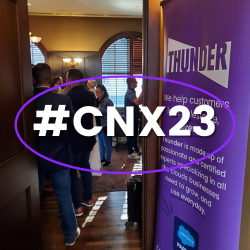BLOG
CNX23 Recap
Written by Daniel Barnett, VP, Marketing & Marketing Cloud Practice Lead at Thunder


These days, nothing is more enjoyable to marketers than catching up, exchanging ideas, and collectively, and as a group, blaming sales.
I kid, nothing like a Dad Joke for Father’s Day… Back to our opening.
Salesforce’s Connections is a can’t-miss, annual event where marketers can ramp up on the latest trends in customer engagement and learn how the Salesforce ecosystem is innovating and adapting to its exciting new capabilities. This year was no different, with a plethora of announcements and informative side-sessions, Connections did nothing but build on the past and lay the groundwork for the next 9-12 months.
A lot was announced, but here are the main talking points worth your time.
